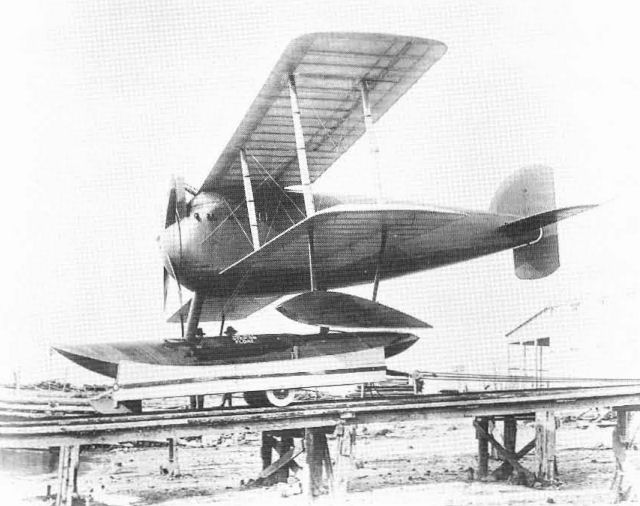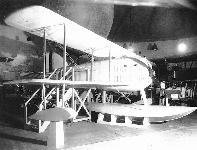
Описание
Страна: США
Год: 1918
Fighter seaplane
P.Bowers Curtiss Aircraft 1907-1947 (Putnam)
Model HA (Model 16)
The HA series of 1918 had no connection with the H-series flying-boats that originated in 1914. The HA was not even a Curtiss design; it was designed by Captain B. L. Smith of the US Marine Corps, and the Curtiss Engineering Corporation at Garden City was given a contract to build a prototype in December 1917. Two others were ordered later. Powered with the new Liberty engine, the two-seat seaplane was named Dunkirk Fighter because it was intended to establish Allied air superiority over the Belgian coastal area around Dunkirk, then held by the Germans.
Construction of the first HA, Navy serial A2278, was conventional wood and fabric, but there were several notable departures from standard configuration. The Liberty engine was entirely buried in the nose of a fat fuselage that was rounded out by formers and stringers outside of the basic rectangular structure. The nose was tipped with a large-diameter spinner. The single main float was mounted on two centreline struts and was stabilized by bracing wires running out to the inner bay of wing struts. The wing arrangement was unusual in that the upper wing, which had its roots resting on the top of the fuselage, was rigged with dihedral while the lower wing was rigged with anhedral. The pilot in the forward cockpit sat in a large cutout behind the rear spar of the upper wing while the gunner had a conventional cockpit and two-gun Scarff ring.
The first HA was ready for flight on 21 March, 1918. It was so tail heavy as to be almost unmanageable in the air and Curtiss's best pilot Roland Rohlfs managed to bring it down in a series of swoops to a crash landing that destroyed the aeroplane.
HA-1 - Curtiss was then given a contract for two additional HAs, Navy serials A4110 and 4111, and some parts of the first one were incorporated into a considerably revised second prototype designated HA-1. Main changes were redesigned vertical tail surfaces with fixed vertical fin area above and below the fuselage, a more rearward location for the wings, and deletion of the spinner in favour of a nose radiator installation. Price less GFE was $42,900.
The performance of the A4110 was greatly improved, but it caught fire in the air. Pilot Rohlfs got it down safely but A4110 was a total loss.
HA-2 - The third HA was fitted with entirely new wings and became the HA-2. The new wings were of two-bay type with no dihedral on either panel. A centre section for the upper wing was held above the fuselage on conventional struts. The Armistice ended further military development of the HA design but the speed of the surviving example encouraged the Navy to enter it in the postwar Curtiss Marine Trophy Race for Service seaplanes. Cost was $42,900 less GFE.
HA Mail - In 1919, Curtiss developed a landplane version of the HA-1 into a single-seat mailplane for the Post Office Department, which was then operating the US Air Mail service. The pilot was moved to the former rear cockpit location and the front cockpit was converted to a mail and cargo compartment. After trying one with single-bay wings, Curtiss sold three two-bay HA mailplanes to the Post Office for $12,000 each less engines.
HA-1
Fighter seaplane. Pilot and gunner.
360 hp Liberty.
Span 36 ft (10,97 m); length 30 ft 9 in (9,37 m); height 10ft 7 in (3,22 m); wing area 387 sq ft (35,95 sq m).
Empty weight 2,449 lb (1,110 kg); gross weight 3,602 lb (1,634 kg).
Maximum speed 126 mph (202,77 km/h); climb 9,000 ft (2,743 m) 10 min; service ceiling 19,000 ft (5,791 m); endurance (full throttle) 2 1/2 hr.
HA-2
Fighter seaplane. Pilot and gunner.
360 hp Liberty.
Span 42 ft (12,8 m); length 30 ft 9 in (9,37 m); height 11 ft 5 in (3,47 m); wing area 490 sq ft (45,52 sq m).
Empty weight 2,946 lb (1,336 kg); gross weight 3,907 lb (1,772 kg).
Maximum speed 118 mph (189,89 km/h); climb 7,900 ft (2,408 m) 10 min; endurance (full throttle) 2 1/2 hr.
Armament (both types) - two fixed and two flexible machine-guns.
Описание:
- P.Bowers Curtiss Aircraft 1907-1947 (Putnam)
- G.Swanborough, P.Bowers United States Navy Aircraft Since 1911 (Putnam)
- W.Green, G.Swanborough The Complete Book of Fighters
Фотографии
-
P.Bowers - Curtiss Aircraft 1907-1947 /Putnam/
The first HA was excessively tail heavy and crashed on its first night.
-
Форум - Breguet's Aircraft Challenge /WWW/
It is pictured in its initial form prior to its first flight on March 21, 1918. It was the US Navy's first fighter.
-
W.Green, G.Swanborough - The Complete Book of Fighters
Prototype Curtiss HA, also known as the "Dunkirk Fighter", intended to serve in Europe.
The second HA (later HA-1) contained some parts of the first but was a new aeroplane with a later Navy serial number. -
G.Swanborough, P.Bowers - United States Navy Aircraft since 1911 /Putnam/
The Curtiss HA-1 single-float fighter.
-
Jane's All The World Aircraft 1919 /Jane's/
The Curtiss two-seat HA Dunkirk fighter of 1918, intended for fighter and escort work. Not operational. Maximum speed 132 mph. (Liberty 400 h.p. engine).
-
P.Bowers - Curtiss Aircraft 1907-1947 /Putnam/
The HA·2 differed from the HA-1 mainly in wing and engine cowling detail.
-
P.Jarrett, K.Munson - Biplane to Monoplane: Aircraft Development, 1919-39 /Putnam/
'One of the most alarming and unstable machines ever to attempt a maiden flight', the Curtiss HA hydroaeroplane was tamed by the masterly handling of tyro test pilot Roland Rohlfs.
-
P.Bowers - Curtiss Aircraft 1907-1947 /Putnam/
The HA was tested on wheels as a mail plane. The short wings were unsatisfaclory and two-bay wings of the HA-2 type were installed on the three sold to the US Post Office.
-
Jane's All The World Aircraft 1919 /Jane's/
A Curtiss experimental Single-Seat Fighter (400 h.p. K.12 Curtiss engine). A very high speed single-seat fighter.
-
P.Bowers - Curtiss Aircraft 1907-1947 /Putnam/
Model HA-1.
-
W.Green, G.Swanborough - The Complete Book of Fighters
The Curtiss HA-2 of which only a single prototype was built, differed from the HA in respect of wing and engine cowling detail.











